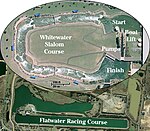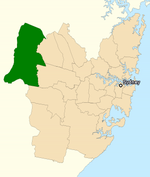The Penrith Museum of Fire is an Australian firefighting museum that contains heritage-listed former operating and stored for preservation fire service vehicles located in Penrith, Sydney, Australia. The provenance of the firefighting vehicles date from 1841 to 1998. The fleet of vehicles was added to the New South Wales State Heritage Register on 25 February 2013.In addition to the Fire and Rescue NSW Heritage Fleet, included in the museum are the heritage-listed:
1898 Shand Mason Curricle Ladders, designed and built by Shand Mason & Company of London from 1898 to 1898. It is also known as Shand Mason Curricle Ladders (1898) and No. 4 Curricle Ladders; added to the New South Wales State Heritage Register, also on 25 February 2013;
1869 Shand Mason 7 inch Manual Fire Engine, designed and built by Shand Mason Company of London from 1869 to 1869. It is also known as Shand Mason 7 inch Manual Fire Engine (1869), No. 1 Manual Engine and No. 1 Manual Pumper; added to the New South Wales State Heritage Register, also on 25 February 2013;
1942 Ford 21W Fire Brigade Mobile Canteen, the motor and chassis designed and built by Ford Motor Company, the body designed and built by NSW Fire Brigades workshops, and the interior built by Gough Brothers & F. G. O'Brien from 1943 to 1944. It is also known as Ford 21W Fire Brigade Mobile Canteen (1942); added to the New South Wales State Heritage Register, also on 25 February 2013.
1909 Edward Smith Headquarters Switchboard, designed and built by Edward Smith in 1909. It is also known as Edward Smith Headquarters Switchboard (1909); added to the New South Wales State Heritage Register, also on 25 February 2013.
1939 Dennis Big 6 Fire Engine, the chassis designed and built by Dennis Bros, Guildford, England and the body designed and built by NSW Fire Brigades workshops in 1939. It is also known as Dennis Big 6 Fire Engine (1939) and No. 132 ME; added to the New South Wales State Heritage Register on 3 December 2004;
1929 Ahrens Fox PS2 Fire Engine, designed and built by Ahrens Fox Co, Cincinnati and Ohio in 1929. It is also known as Ahrens Fox PS2 Fire Engine (1929) and No. 8 ME; added to the New South Wales State Heritage Register, also on 3 December 2004;
1891 Shand Mason Fire Engine, designed and built by Shand Mason & Company of London in 1891. It is also known as Shand Mason Fire Engine (1891) and Big Ben; No. 18 Steamer; added to the New South Wales State Heritage Register, also on 3 December 2004; and
NSW Fire Brigades No 10 Vehicle Number Plates, designed and built in 1910 by unknown private contractors to the then NSW Government registering authority. It is also known as Number 10 vehicle number plates (collection); added to the New South Wales State Heritage Register on 5 April 2002.






